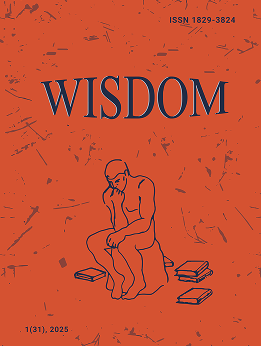Philosophical Conception of Stable Verse Forms (Based on Yeghishe Charents’s Poetry Analysis)
DOI:
https://doi.org/10.24234/wisdom.v3i2.868Keywords:
Yeghishe Charents, sonnet, triolet, ghazal, ruba’i, distich, monostich, bait, rondeau, tanka, haikuAbstract
The article is dedicated to the analysis of stable verse forms in the poetry of great Armenian poet Yeghishe Charents (1897-1937), introducing the structural opportunities for the development of the theme and the idea with some philosophical logic. It has long been criticized that the structure of these verse forms has a clear logic, the roots of which come from ancient and medieval ritual art. Many of the stable forms of Roman poetry (sonnet, triolet, rondel, rondeau, etc.) arose from widespread national dance songs that were popular in medieval Europe, inheriting the lengthy stanza of three parts typical to them, which, in its turn, is associated with the triad often encountered in antique tragedies and odas (strophe, antistrophe and epode). Triolet, sonnet and rondeau resemble ancient superstrophe in their structure, showing the same logic of the development of the theme. Stable forms from Eastern poetry (ruba’i, ghazal, mukhammaz, etc.) also have sound principles of structure and rhyme, which contribute to the expression of their philosophical content. The poetry of Yeghishe Charents, rich in stable verse forms, provides a vast opportunity to demonstrate the philosophical conception of the connection between their form and content.
Downloads
References
Abeghyan, M. (1971). Erker (Works, in Armenian). (Vol. 5). Yerevan: ASSR Academy of Science Publication.
Becher, J. (1965). Filosofiia soneta, ili Malen’koe nastavlenie po sonetu (Philosophy of the sonnet, or a Little instruction on the sonnet, in Russian). Voprosi literaturi (Literature Questions, in Russian), 10, 190-208.
Charents, Ye. (1962). Erkeri joghovatsu (Set of works, in Armenian). (Vol. 1). Yerevan: ASSR Academy of Science Publication.
Charents, Ye. (1964). Erkeri joghovatsu (Set of works, in Armenian). (Vol. 3). Yerevan: ASSR Academy of Science Publication.
Charents, Ye. (1967). Erkeri joghovatsu (Set of works, in Armenian). (Vol. 6). Yerevan: ASSR Academy of Science Publication.
Charents, Ye. (1968). Erkeri joghovatsu (Set of works, in Armenian). (Vol. 4). Yerevan: ASSR Academy of Science Publication.
Charents, Ye. (1983). Antip ev chhavakvatc erker (Unpublished and uncollected works, in Armenian). Yerevan: ASSR Academy of Science Publication.
Gadamer, H.-G. (1988). Istina i metod. Osnovi filosofskoi germenevtiki (Truth and method. Funda-mentals of philosophical hermeneutics, in Russian). Moscow: “Progress” Publication.
Gasparov, M. (1989). Ocherk istorii evropeiskovo stikha (Essay on the history of European verse, in Russian). Moscow: “Nauka” Publication.
Gasparyan, D. (1979). Sovetahay poeziayi taghachaput’yuny (The metrics of Soviet Armenian poetry, in Armenian). Yerevan: ASSR Academy of Science Publication.
Jakobson, R. (1975). Lingvistika i poetika (Linguistics and poetics, in Russian). In E. Basin, & M. Polyakov, Structuralizm “za” i “protiv”, Sbornik statei (Structuralism “for” and “against”, Set of articles, in Russian) (pp. 193-230). Moscow: “Progress” Publication.
Landy, J. (2021). Lyric self-fashioning: Sonnet 35 as a formal model. Philosophy and Literature, 45(1), 224-248. https:/doi.org/10.1353/phl.2021.0015
Ostankovich, A., & Shpak, E. (2013). Sinergeticheskii potencial tviordikh form stikha (rondo, pon-del’, triolet) (Synergistic potential of stable verse forms (Rondo, rondel, triolet), in Russian). Vestnik Severo-Kavkazskovo federal’novo universiteta (Bulletin of the North Caucasian Fed-eral University, in Russian), 4(37), 154-158.
Schlegel, A. (1983). Estetika. Filosofiia. Kritika (Aesthetics. Philosophy. Criticism, in Russian). (Vol. 2). Moscow: “Iskusstvo” Publication.
Zhirmunsky, V. (1975). Teoria stikha (Theory of verse, in Russian). Leningrad: “Sovetskii pisatel’” Publication.
Zis, A. (1987). Filosofskoe mishlenie i khudojestvennoe tvorchestvo (Philosophical thinking and artis-tic creativity, in Russian). Moscow: “Iskusstvo” Publication.
Downloads
Published
How to Cite
Issue
Section
Categories
License
Copyright (c) 2022 scientific journal WISDOM

This work is licensed under a Creative Commons Attribution-NoDerivatives 4.0 International License.
Creative Commons Attribution-Non-Commercial (CC BY-NC). CC BY-NC allows users to copy and distribute the article, provided this is not done for commercial purposes. The users may adapt – remix, transform, and build upon the material giving appropriate credit, and providing a link to the license. The full details of the license are available at https://creativecommons.org/licenses/by-nc/4.0/.















